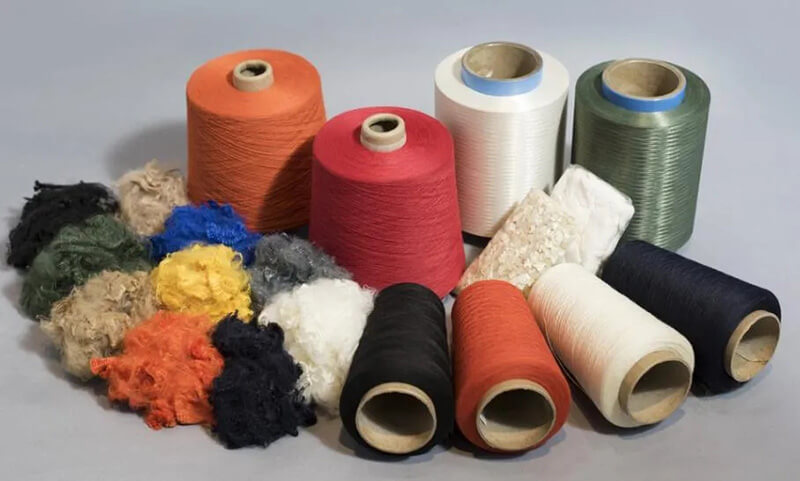What is yarn?
Yarn includes yarn and thread, which is a collective term for yarn.
Yarn is a form of fiber assembly, with slender and soft characteristics.
The difference between yarn and thread
Yarn is made by twisting bundled fibers;
thread is made by twisting two or more yarns.

Classification of yarn
1 Classified by thickness
Number system classification British system classification
Extra fine yarn with less than 10tex, extra high count, 60 British counts,s and above
Fine yarn 11-20 tex fine count 58-29 British count
Medium yarn 21-30 tex, 28-19 British yarn
Coarse yarn 32 tex and above Coarse count 18 British yarn and below
2 Classified by purpose
Weaving yarn: warp yarn, weft yarn, pile yarn, decorative yarn.
Knitting yarn: weft knitting yarn, warp knitting yarn, pile yarn, decorative yarn, towel yarn, sewing thread yarn, embroidery thread yarn, civil thread yarn, special yarn, functional yarn.
3 According to fiber type
Pure spinning yarn: cotton yarn, hemp yarn, short fiber, filament yarn, wool yarn, spun yarn, blended yarn.
4 According to the spinning system
Carded yarn, combed yarn, woolen yarn, worsted yarn, etc.
5 According to shape and structure
Single yarn, stranded yarn, monofilament, multifilament, bulked yarn, textured yarn, core-spun yarn, fancy yarn, slub yarn, untwisted yarn, wrapped yarn, etc.
6 According to the spinning method
Ring spinning: ordinary ring spinning, compact spinning, Siro spinning.
Open-end spinning: open-end spinning, air-jet spinning, dust cage spinning, electrostatic spinning, self-twist spinning, composite spinning, etc.
Spinning process and function
1 The purpose of matching cotton
- Meet the requirements of yarn quality.
- Keep production relatively stable.
- Make full use of the characteristics of various raw materials.
- Reasonably reduce costs.
2 Blending method
- Artificial blending Mixed cotton pile: about 0.5 tons / pile (currently eliminated)
Small amount of cotton blending: about 25KG (currently eliminated) - cotton bale blended cotton Rotary catch cotton, about 2 tons/reel reciprocating catch cotton 3, sliver mixed cotton
3 Opening and cleaning cotton and its function
- Open: open, loosen the compressed fiber material into a smaller block or bundle fiber (a few milligrams to tens of milligrams per block).
- Clear: remove large impurities and defects in fiber raw materials (about 60%).
- Mixing: mixing, preliminarily mixing fibers of different specifications and properties.
- Uniformity: A semi-product (fiber roll or fiber flow) suitable for the processing requirements of the next process with a certain degree of uniformity is made. *The length of the fiber roll is between 34.2~43.2m and the weight is 16~20kg. Fiber roll dry weight: Coarse yarn 420~450g/m Medium yarn 390~420g/m fine gauge yarn 360~390g/m extra fine gauge yarn 320~360g/m
4 Carding and function
- Combing: combing, carefully combing the fiber block or bundle transferred from the previous process to make it into a single fiber state.
- Impurity removal: The fine impurities and defects in the fiber are further removed by combing.
- Mixing: Mix the fibers thoroughly.
- Sliver: Make the fibers gather into strips, called card sliver, and place it in the can regularly, which is convenient for processing in the next process. Dry weight of raw sliver: 32tex or more yarn 22~28g/5m 20~30tex 19~26g/5m 12~19tex 16~24g/5m under 11tex 16~22g/5m
5 Combing and function
- Combing: fine combing, fine combing the sliver made of carded card sliver, so that the fibers are further straightened, paralleled and separated (the parallel straightness of the fibers can be increased from 50% to 90% of the card sliver about)
- Exclusion: For short fibers with a fixed length (below 16.5mm), the exclusion rate is about 45%, which improves the uniformity of the fibers.
- Impurity removal: remove neps and impurities contained in fibers.
- Make combed sliver with uniform sliver and certain weight.
- Put the combed sliver into the can according to a certain rule to facilitate the next process. Combed sliver basis weight: special fine yarn: 10.5~14g/5m fine medium yarn: 13.5—15.5g/5m T/C yarn: 18.5-21g/5m
6 Draw and function
- Combination: Combine 6-8 combed cotton or combed slivers to make up for the uneven thickness between the slivers to improve the uniformity of the slivers.
- Drafting: At the same time as merging, carry out drafting (thinning and lengthening) which is slightly larger than the number of merging.
- Mixing: Through the effects of merging and drafting, the fibers are fully mixed.
- Straightening: Under the action of drafting, the fibers are further straightened and paralleled.
- Sliver making: make fiber bundles of a certain weight and regularly circle them into the can to facilitate the processing of the next process.
The dry quantity of cooked strips:
above 32tex 19~23g/5m 20~30tex 15~20g/m
13~19tex 13~18g/5m 9~13tex 11~15g/m
*The selection of the number of drawing process passes:
pure cotton
chemical fiber blend
7 Woolen spinning and function
- Drafting: The cooked sliver is stretched by 5-12 times (the stretching ratio of the imported roving machine is 2.5-24.2 times) to make a certain fineness of roving.
- Straightening: The fibers are further straightened and paralleled by drawing.
- Twisting: A small amount of twisting (2.13~1.01 twist/10cm) is applied to the drafted sliver, and it is spun into a slightly stronger roving.
- Winding: The roving is wound into an orderly manner to facilitate the unwinding of the worsted spinning process.
Roving dry weight:
above 32tex 5.5~10.0g/10m 20~30tex 4.1~6.5g/10m
9.0~19tex 2.5~5.5g/10m 9.0tex or less 1.6~4.0g/10m
*In the old-fashioned woolen spinning process, two passes are generally required, and even three woolen processes are required when spinning high-count yarns.
The first roving machine is fed with a single sliver, and after 3~4 times mechanical drafting, it is spun into the first roving of 660~1250 tex (0.9s~0.47s); the second roving machine is fed with two first rovings , After 4~5 times mechanical drafting, spun into 230~650tex (2.5s~0.9s) two-pass roving; three-pass roving machine is fed with two second-pass rovings and 4~5 times mechanical draft (weight Drafting 2~2.5 times), spinning into three rovings of 100tex~220tex (5.8s~2.7s).
8 Worsted spinning and function
- Drafting: The worsted spinning process is the last process of yarn formation. Therefore, drafting the roving to a certain number is the primary task of the worsted spinning project.
- Twisting: Twist the drafted strand to make it into a spun yarn with a certain strength.
- The spun yarn is wound on an appropriate bobbin in an orderly manner to facilitate post-processing and unwinding during use.
*The draft ratio of worsted spinning process is generally 10~50 times.
Related Article
Circular knitting machine basic operation knowledge
Read moreCircular knitting machine basic operation knowledge
